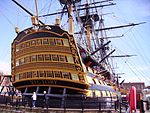HMNB Portsmouth

His Majesty's Naval Base, Portsmouth (HMNB Portsmouth) is one of three operating bases in the United Kingdom for the Royal Navy (the others being HMNB Clyde and HMNB Devonport). Portsmouth Naval Base is part of the city of Portsmouth; it is located on the eastern shore of Portsmouth Harbour, north of the Solent and the Isle of Wight. For centuries it was officially known as HM Dockyard, Portsmouth: as a Royal Dockyard, Portsmouth functioned primarily as a state-owned facility for building, repairing and maintaining warships; for a time it was the largest industrial site in the world.From the 1970s, the term 'Naval Base' began to be used for Portsmouth (and other Royal Dockyards), acknowledging a greater focus on personnel and support elements alongside the traditional industrial emphases. In 1984 Portsmouth's Royal Dockyard function was significantly downsized and downgraded, and was formally renamed the 'Fleet Maintenance and Repair Organisation' (FMRO). The FMRO was privatised in 1998; in 2002, shipbuilding (which had not taken place on site since the late 1960s) resumed in the form of block construction, but this again ceased in 2014.Today, Portsmouth is the home base for two-thirds of the Royal Navy surface fleet, including the two aircraft carriers, HMS Queen Elizabeth and HMS Prince of Wales. Naval logistics, accommodation and messing are provided on site, with personnel support functions (e.g. medical and dental; education; pastoral and welfare) provided by Defence Equipment and Support. Other functions and departments, e.g. Navy Command Headquarters support staff, are also accommodated within the Naval Base. The base is additionally home to a number of commercial shore activities, including the ship repair and maintenance facility operated by BAE Systems Maritime. The base is the oldest in the Royal Navy, and it has been an important part of the Senior Service's history and the defence of the British Isles for centuries. It is home to one of the oldest surviving drydocks in the world. The former Block Mills are of international significance, having been the first factory in the world to employ steam-powered machine tools for mass production. The Royal Naval Museum has been on the site since 1911. In 1985 a partnership between the Ministry of Defence and Portsmouth City Council created the Portsmouth Naval Base Property Trust to manage part of the historic south-west corner of the Naval Base, under a 99-year lease, as an heritage area, the Portsmouth Historic Dockyard. It allows members of the public to visit important maritime attractions such as Mary Rose, HMS Victory, HMS Warrior and the National Museum of the Royal Navy.
Excerpt from the Wikipedia article HMNB Portsmouth (License: CC BY-SA 3.0, Authors, Images).HMNB Portsmouth
Queen Street, Portsmouth Portsea
Geographical coordinates (GPS) Address External links Nearby Places Show on map
Geographical coordinates (GPS)
| Latitude | Longitude |
|---|---|
| N 50.804419444444 ° | E -1.1024194444444 ° |
Address
HMNB Portsmouth (HMS Nelson)
Queen Street
PO1 3HX Portsmouth, Portsea
England, United Kingdom
Open on Google Maps










